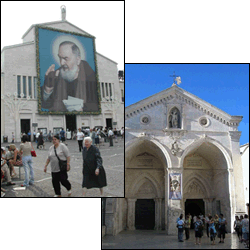| |
ITINERARIES |
| |
UNESCO
WORLD HERITAGE 1996 |
 |
Castel
del Monte (Ba)
A unique
masterpiece of medieval military architecture,
a successful blend of classical antiquity, Muslim
East, and North Europe Cistercian Gothic. The
mathematical proportion, number 8, the mystery
and the myth of the great emperor Frederick
II of Hohenstaufen. |
 |
The
Trulli of Alberobello (Ba)
The fairy
town of Trulli. Limestone dwellings, remarkable
examples of drywall constructions. They feature
pyramidal, domed or conical roofs built up of
corbelled limestone slabs. Alberobello is of
outstanding value being exceptional the technique
deriving from prehistoric construction, survived
in the modern world. |
| |
APULIAN
ROMANESQUE STYLE |
 |
Bari
and the Basilica of St. Nicholas
Bari faces the Mediterranean Sea and holds wide
religious significance throughout Europe and the
Christian world. The Basilica houses the relics
of the most adored Saint in the world: Santa Klaus.
It is an important pilgrimage destination both
for Catholic and Orthodox Christians from Eastern
Europe. The Basilica in Romanesque-Apulian architectural
style set a precedent which was later imitated
all over Apulia. A nice stroll throughout the
medieval old town leads to the imposing Norman-Swabian-Aragonese
castle residence of the greatest emperors and
governors. |
 |
Trani
and the Cathedral of St Nicholas The Pilgrim 1099
The city of Turenum appears for the first time
in Tabula Pentingeriana. The 11th century was
the most flourishing age, the port, the Crusades,
the Norman Swabian Castle, the Episcopal siege,
the Jewish community with the Synagogue of Santa
Maria Scolanova are witnesses of a glorious past.
Since 1099 the Romanesque Cathedral housed the
mortal remains of St Nicholas the Pilgrim, a young
Greek died in Trani and immediately canonized
by Pope Urban II. The visitor will be fascinated
by the unbelievable Duomo which seems to be built
to sail the sea. |
 |
A
nice walk throughout the Romanesque Apulian Cathedrals
The Romanesque highlights show the Norman architecture
remarkable influenced by Frederick II.
Starting from the findings of the cathedral in
Ruvo, XIII century, we are fascinated
by the hypogean site where Peucetian and Roman
tombs, the Paleochristian Basilica are found.
Palazzo Jatta houses the Archaeological
Museum. Where it is worthwhile to admire some
of the best known artworks by Apulian and Greek
ceramic artists and painters, Daunian jars and
black and coloured vases, an Attic vase with red
figures by Talos, which dates back to the 5th
Century BC. Keep on our tour arrive in Bitonto
and on its impressive cathedral façade
a pelican acting the role of the generosity in
the Christian church. Through the main door ,
called “Della Scomunica“, Pope Gregory
IX excommunicated the great Emperor Frederick
II. Few kilometres away meet Andria
whose Cathedral houses the tombs of Yolanda from
Brienne and Elisabeth from England, both of them
married with Frederick II. At the end a gorgeous
meeting … at Sweet Museum. Sweetmeats,
it is worth a taste !!! |
| |
ROMANESQUE
AND GOTHIC ARTCHITECTURE |
 |
Barletta,
the Cathedral, Eraclio, and the Cantina della
Disfida
The tour starts from the imposing Norman –Swabian
- Aragonese castle passing under the famous bell
tower and get to the Cantina della Disfida where
Guy De La Motte, a french knight, challenged the
Spaniards by means of Ettore Fieramosca. Keeping
on the way the Baroque Palazzo della Marra which
houses a permanent exhibition of the painter G.
De Nittis. Turning around the Colosso a 4th century
bronze statue more than 5 metres high overlooks
the square. An elegant strip leads to the Romanesque
– Gothic Cathedral devoted to Santa Maria
Maggiore. Under the basement two previous Cathedral
dated back to VI and X century can be visited. |
 |
Altamura,
the Cathedral, the Megalithic walls, the Dinosaurs
footprints and the Prehistoric Man
Altamura keeps many monuments to be visited. Megalithic
walls , a necropolis, Bronze Age findings, footprints
of dinosaurs, the prehistoric man nicknamed Ciccillo,
the Pulo, a karsts dolina and its Dop bread. Altamura
was well known as Alter Ilium, Frederick II built
an imposing Romanesque – gothic Cathedral
which was considered by the Pope as one of the
four Palatine Churches in Apulia amongst Acquaviva,
Bari, Monte S. Angelo. It is worth to taste the
famous bread! |
| |
FOLKLORE
AND ART |
 |
Putignano:
the allegorical carts and Farinella a popular
mask
The longest Carnival, the rite of layers, allegorical
carts, papier-mâché workshops interesting
topics in a " Nullius " city depending
on the Pope. The knights of Malta had their feud
and the Palazzo del Balì shows the history.
Its foundation dates back to the 4th. In the old
town the church of Saint Peter Apostle looks onto
the main square. The Baroque church of Saint Maria
dei Greci preserves Saint Stephen shrine shaped
as a head of a crusader. The Church of Saint Domenico
with its 17th century bell tower was the jail
of Wolfgang Goethe’s Italian teacher: Domenico
Giovinazzi. In the outskirts the karst system
shows an interesting cave called Trullo.
A suggestive memory leaves the hypogean Sanctuary
of St. Michael which keeps a statue of the Archangel
made by the famous artist Stefano da Putignano. |
| |
THE
WORSHIP |
 |
Monte
Sant'Angelo and San Giovanni Rotondo represent
the religiousness in Apulia
Since Frederick II times these two worship towns
showed an extraordinary mystical tradition. In
490 B.C. the first apparition of the archangel
in the cave of St. Michael. The visit is an experience
of great suggestion. From the past to the XX century
we meet Padre Pio from Pietralcina. His faith
and love lead the believers all over the world
to gather together in prayer in the Sanctuary
of San Giovanni Rotondo. Love and joy will fill
your mind and soul visiting his grave. |
|